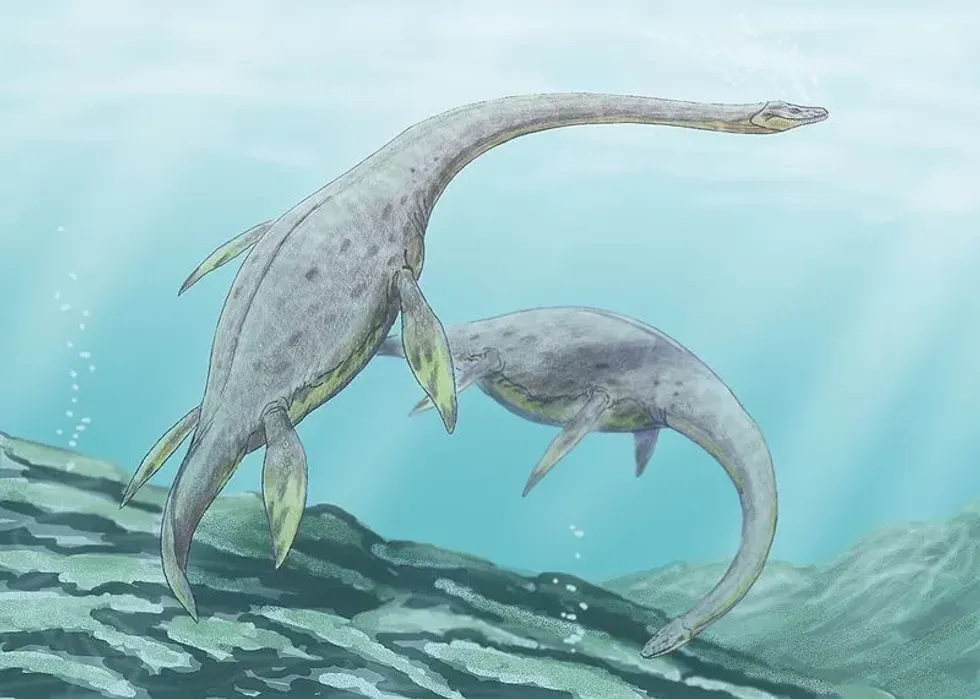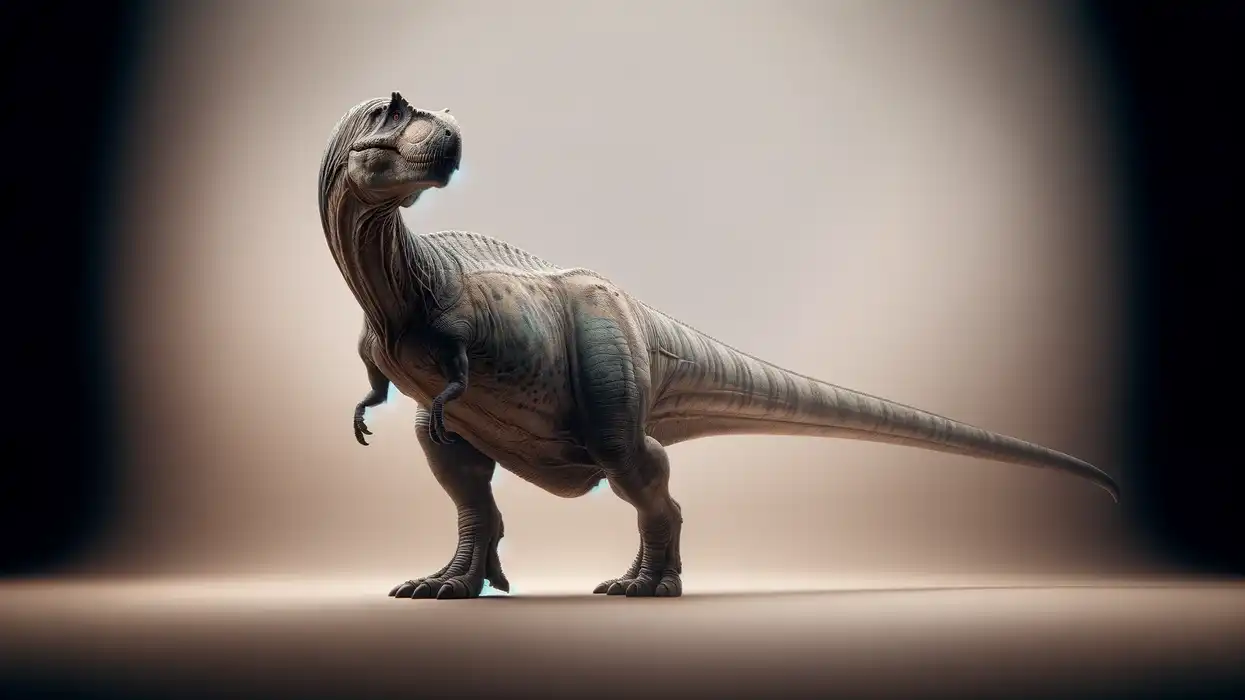Muraenosaurus is an extinct genus of plesiosaurs that lived during the Middle Jurassic. Plesiosaurs were marine reptiles of the Mesozoic Era with flat bodies and limbs in the form of flippers that they used for moving in the sea.
Muraenosaurus has been classified as a member of the family Cryptoclididae, which consists of plesiosaurs that had long necks and small skulls.
The first Muraenosaurus specimen was collected by Charles Leeds in the Oxford Clay Formation in Southern England. Although it was damaged during excavation and parts of the skull and all caudal vertebrae were missing, the fossils still formed an almost complete skeleton of the animal.
It was later named and described by Harry G. Seeley in 1874 and published in a paper released in the Quarterly Journal of the Geological Society of London.
The name comes from the Latin word 'Muraena', meaning eel, after the Moray eels and the long eel-like structure of the neck of this plesiosaur. Thus, the Muraenosaurus name means 'Moray eel lizard'.
The type species for the genus was named Muraenosaurus leedsi or leedsii, after Charles Leeds, who collected the first specimen. It also has three other species currently under its classification as a genus.
The species M. reedii and Picrocleidus beloclis that were earlier considered to be species or synonyms of Muraenosaurus have now been given a different classification.
While M. reedii is now considered to be a synonym of Pantosaurus, Picrocleidus beloclis has now been put into its own genus, Picroleidus. Here are some fun and interesting facts about this unique plesiosaur!
If you want to know more about other similar animals, be sure to explore our Woolungasaurus interesting facts for kids and Thalassomedon facts for kids pages.
Muraenosaurus Interesting Facts
Was the Muraenosaurus a dinosaur?
Muraenosaurus was not a dinosaur. It was a marine reptile called a plesiosaur that lived during the Middle Jurassic and belonged to the order Plesiosauria within the much larger group Sauropterygia.
How do you pronounce 'Muraenosaurus'?
The name of the genus Muraenosaurus is phonetically pronounced as 'Mu-ray-no-sore-us'.
What type of marine reptile was a Muraenosaurus?
Muraenosaurus was a plesiosaur and has been classified as a member of the family Cryptoclididae because of certain physical features such as an extremely long neck and a small head.
Cryptoclidids lived during the Middle Jurassic till the end of the Cretaceous period, and are also known to have had sharp conical teeth which they used to attack and feed on fish with.
However, at the time of its discovery, it was thought by Harry G. Seeley, who described it and gave it a name, to belong to the family Elasmosauridae as members of that family also have similar features of long necks and small heads.
After further research, it was then placed in the correct family.
In which geological period did the Muraenosaurus live?
The fossil remains of this plesiosaur were dated back to 164.7-163.5 million years ago, which implies that these animals would have lived during the Callovian age of the Middle Jurassic period.
When did the Muraenosaurus become extinct?
All plesiosaurs are thought to have gone extinct due to the Cretaceous-Paleogene extinction event. Thus, Muraenosaurus would have also died off almost 66 million years ago at the end of the Cretaceous period.
Where did a Muraenosaurus live?
Although plesiosaurs had a worldwide distribution during the Mesozoic Era, fossils of this marine animal have only been found from the Oxford Clay Formation. Therefore, it would have lived in the seas that covered the countries now known as England and France.
What was a Muraenosaurus' habitat?
The sea these animals lived in would have been shallow with warm waters as the light would have been able to reach deep in these shallow waters. The depth of the sea is estimated to have been less than 164 ft (50 m).
Who did a Muraenosaurus live with?
The social structure of these plesiosaurs is not known due to lack of evidence and research, but they would have coexisted with other marine animals of the Jurassic period, such as mollusks, arthropods, teleost fish, snails, and slugs.
How long did a Muraenosaurus live?
There is no information available about the lifespan of these plesiosaurs.
How did they reproduce?
It was first thought that plesiosaurs would crawl up to a beach to lay eggs there, this theory was disproved when it was discovered that the limbs of these animals were not strong enough to drag their large and heavy bodies on land.
Thus, it was suggested that plesiosaurs could be viviparous, and a fossil of a pregnant plesiosaur was discovered in 1987 that proved this theory right.
It is thought that parental care would have been provided to baby Muraenosaurus for quite some time, as in the case of whales.
Muraenosaurus Fun Facts
What did a Muraenosaurus look like?

Muraenosaurus were medium-sized plesiosaurs with unusually long necks but small and broad skulls. This is evident from the fact that out of 66 pre-sacral vertebrae that were found of this animal, 44 of them belonged to the neck, and the skull was only about 15 in (37 cm) long.
Their forelimbs also resembled those of Pliosaurus more than any other plesiosaur.
How many bones did a Muraenosaurus have?
Since a complete Muraenosaurus skeleton has not been found yet, the total number of bones that this animal possessed cannot be quantified.
How did they communicate?
It is unclear whether or how these animals communicated with each other.
How big was a Muraenosaurus?
M. leedsi was a medium-sized plesiosaur with an average body length of 16-20 ft (5-6 m). This was about three times less than the length of one of the largest plesiosaurs, Elasmosaurus.
How fast could a Muraenosaurus move?
These were extremely slow animals and would have swum at a speed of around 1-3 mph (1.8-5.4 kph).
How much did a Muraenosaurus weigh?
The weight of a Muraenosaurus has not been evaluated due to a lack of evidence and research.
What were the male and female names of the species?
There were no sex-specific names for male and female plesiosaurs of this genus.
What would you call a baby Muraenosaurus?
No special name has been given to a baby Muraenosaurus.
What did they eat?
Although earlier their diet was assumed to have been piscivorous, some fossil remains were collected with the contents of their stomachs, which proved that these animals fed on teleost fish, and cephalopods like squids and octopuses.
They would also have had plenty of predators themselves, such as pliosaurs or sharks.
How aggressive were they?
Muraenosaurus could have been aggressive as they are thought to have stealthily attacked their prey from behind. They can be compared with the modern-day great white sharks.
Did you know...
Plesiosaurs like Muraenosaurus could have had gastroliths or stones in their stomach. Aside from helping them process and digest hard-shelled food, it was suggested that the gastroliths would have helped them with buoyancy issues and stabilizing their body while in the water.
What adaptations did the Muraenosaurus have?
The major adaptation Muraenosaurus leedsi had was its long neck and its small head. It is thought that its long neck would have helped it attack fish without alerting them to the change in water pressure that might occur if they swam with their neck bent in a certain direction.
It could have also used these features to feed on fishes swimming in the open sea by bending its neck or grazing on organisms that lived down on the seafloor.
Are Muraenosaurus related to whales?
Though it might seem so because of certain shared features between them, plesiosaurs of the genus Muraenosaurus are not related to whales. Both these marine animals had different origins and ancestors from which they evolved.
Here at Kidadl, we have carefully created lots of interesting family-friendly prehistoric animal facts for everyone to discover! For more relatable content, check out these Teleosaurus facts and Zhenyuanopterus facts for kids.
You can even occupy yourself at home by coloring in one of our free printable Muraenosaurus coloring pages.
Image one by Dmitry Bogdanov.
Image two by Nobu Tamura.









